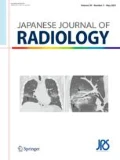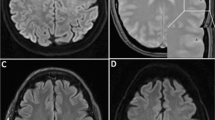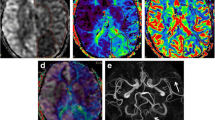Abstract
We report the case of a 64-year-old man with migrainous infarction, giving special attention to chronological changes in neuroimaging findings. Five days after the onset, diffusion-weighted imaging showed slightly high intensity, and the apparent diffusion coefficient map showed increased diffusion in the right occipital lobe, which indicated vasogenic edema. Perfusion magnetic resonance imaging (MRI) and MR angiography demonstrated hyperperfusion of the ipsilateral hemisphere. Follow-up MRI showed irreversible brain damage. These images may reflect chronological changes in cerebral edema due to prolonged hyperperfusion with migraine.
Similar content being viewed by others
References
Headache Classification Committee of the International Headache Society. Classification and diagnostic criteria for headache disorders, cranial neuralgias and facial pain. Cephalagia 1988;8:35–38.
Welch KM, Levine SR. Migraine-related stroke in the contex of the International Headache Society classification of head pain. Arch Neurol 1990;47:458–462.
Jäger HR, Giffin NJ, Goadsby PJ. Diffusion-and perfusion-weighted MR imaging in persistent migrainous visual disturbances. Cephalalgia 2005;25:323–332.
Kruit MC, van Buchem MA, Hofman PA, Bakkers JTN, Terwindt GM, Ferrai MD, et al. Migraine as a risk factor for subclinical brain lesions. JAMA 2004;291:427–434.
Schäbits WR, Fisher M. Diffusion weighted imaging for acute cerebral infarction. Neurol Res 1995;17:270–274.
Kim EY, Ryoo JW, Roh HG, Lee KH, Kim SS, Song IC, et al. Reversed discrepancy between CT and diffusion-weighted MR imaging in acute ischemic stroke. AJNR Am J Neuroradiol 2006;27:1990–1995.
Bkey TA, Uhl M, Carew J, Markl M, Schmidt D, Peter HH, et al. Diagnostic value of high-resolution MR imaging in giant arteritis. AJNR Am J Neuroradiol 2007;28:1727–1727.
Masuzaki M, Utsunomiya H, Yasumoto S, Mitudome. A case of hemiplegic migraine in childhood: transient unilateral hyperperfusion revealed by perfusion MR imaging and MR angiography. AJNR Am J Neuroradiol 2001;22:1795–1797.
Lindahl AJ, Allder S, Jefferson D, Allder S, Moody A, Martel A. Prolonged hemiplegic migraine associated with unilateral hyperperfusion on perfusion weighted magnetic resonance imaging. J Neurol Neurosurg Psychiatry 2002;73:202–203.
Lindner A, Reiners K, Toyka KV. Meningeal hyperperfusion visualized by MR in a patient with visual hallucinations and migraine. Headache 1996;36:53–57.
Crawford JS, Konkol RJ. Familial hemiplegic migraine with crossed cerebellar diaschisis and unilateral meningeal enhancement. Headache 1997;37:590–593.
Smith M, Cros D, Sheen V. Hyperperfusion with vasogenic leakage by fMRI in migraine with prolonged aura. Neurology 2002;58:1308–1309.
Hayashi R, Tachikawa H, Watanabe R, Honda M, Katsumata Y. Familial hemiplegic migraine with irreversible brain damage. Intern Med 1998;37:166–168.
Barbour PJ, Castaldo JE, Shoemaker EI. Hemiplegic migraine during pregnancy: unusual magnetic resonance appearance with SPECT scan correlation. Headache 2001;41:310–316.
Pande AR, Ando K, Ishikura R, Nagami Y, Takada Y, Wada A, et al. Clinicoradiological factors influencing the reversibility of posterior reversible encephalopathy syndrome: a multicenter study. Radiat Med 2006;24:659–668.
Abe K, Yoshimura H, Tanaka H, Fujita N, Hikita T, Sakoda S. Comparison of comventional and diffusion-weighted MRI and proton MR spectroscopy in patients with mitochondrial encephalomyopathy, lactic acidosis, and stroke-like events. Neuroradiology 2004;46:113–117.
Lansberg MG, O’Brien MW, Norbash AM, Moseley ME, Morrell M, Albers GW. MRI abnormalities associated with partial status epilepticus. Neurology 1999;52:1021–1027.
Author information
Authors and Affiliations
Corresponding author
About this article
Cite this article
Arai, S., Utsunomiya, H., Arihiro, S. et al. Migrainous infarction in an adult: evaluation with serial diffusion-weighted images and cerebral blood flow studies. Radiat Med 26, 313–317 (2008). https://doi.org/10.1007/s11604-008-0226-y
Received:
Accepted:
Published:
Issue Date:
DOI: https://doi.org/10.1007/s11604-008-0226-y




